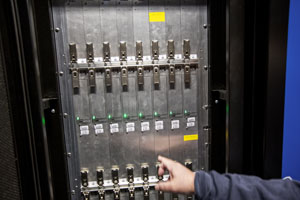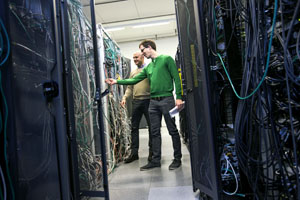Supercomputer opens doors to the universe
The muffled rumble from the fans that cool the super computers is deafening. Data is processed here 24 hours a day, all year round, with a capacity that is hard to grasp.

Simulations are being run at KTH's parallel computer centre, PDC, which are giving old theories new life.
Simulating trials and having computers do the jobs instead of full-scale experiments has its obvious advantages. Since PDC opened some 20 years ago, the number of researchers using super computers has increased in line with the computers' performance.
There are several benefits. The computers' make it possible to study processes which could otherwise not be researched because they are too fast or too microscopically small. What cells do, or processes such as photosynthesis, are examples of such research fields.
"In other words, we can make more realistic applications and simulations than was previously possible, when a theory or a model might have been available, but it was too complex to calculate or simulate in the computer", says Gert Svensson, deputy director of PDC, which is located under the School for Computer Science and Communication.

PDC is a national centre, so researchers from throughout the country make use of it, with the main computers, Lindgren and Ferlin, booked on an hourly basis. Ferlin, which has around 1,000 cores, or processors, is ideal for industrial research, strength calculations for example. With its 30,000 processors, Lindgren is suitable for really large simulations within chemistry, physics, medicine, and climate research.
Svensson says that there is a major need for parallel and super computer calculations:
"The computers can easily remember one billion telephone numbers, which human beings cannot. The computers are not so good at making associations and seeing patterns, but with parallel processors, very advanced problems can be simulated by dividing then up into small parts, each of which is dealt with by one processor".
The gigantic computer cabinets are positioned side by side in the data centre. Opening a door reveals row upon row of silvery cabinets, each one of which is a computer with 32 processors. In another cabinet, greyish-black cables, which help the computers to communicate and exchange information, are coiled around each other. By inputting various possible variables for what is to be measured, for example, if you want to look at an atom at a particular point in time, in a particular location, at a particular speed, you can then visualise and print out descriptions of the sequence. However, you have to know what you are looking for in the hunt for deviations. One minor incorrect detail can have a major impact on the results. As the information required can be modelled in innumerable combinations and countless variants, you have to know what you're doing.
"As always, it is important to ask the right questions, so that the right things are measured. Otherwise there is the risk of drowning in information.

Computer capacity is developing at a furious pace. Computing power is doubling every 18 months", says Svensson and refers to what he calls the stone age.
"About 40 years ago, we had punched cards. If you were lucky, you received the results on the following day. Now it is usually immediate".
The application experts Rossen Apostolov and Radovan Bast are in the humming data centre. Their work partly involves developing the software for the super computers and helping the researchers to find precisely the right things to measure and search for, and partly entails assisting the researchers to interpret the results.
Molecular dynamic simulations and energy flows at the level of quantum mechanics are two of the things they are working on within medicine and chemistry.
"Old theories can now be confirmed using computer simulations. Hopefully in the future the theories will go hand in hand with the experiments and the models can be confirmed at once", says Rossen Apostolov, who has been working at KTH for three years.
Jill Klackenberg

